MBL502 Finance Report: Financial Management and Investment Analysis
VerifiedAdded on 2023/01/06
|14
|3672
|70
Report
AI Summary
This report provides a comprehensive financial analysis of ABC Pty Ltd, covering key aspects of financial management. It begins with the construction of essential financial statements, including the balance sheet, profit and loss statement, and cash flow statement. The report then delves into the identification and evaluation of various sources of finance, suitable for both start-up and growing businesses, considering factors such as debt, equity, and bank loans. Furthermore, it examines depreciation methods and their impact on financial performance, calculating the firm's additional EBIT and after-tax incremental earnings over a five-year period. The analysis extends to project evaluation, including the calculation of additional free cash flows, net present value (NPV), and project evaluation measures to assess the viability of potential investments. The report aims to provide a detailed understanding of financial management principles and their application in real-world business scenarios.

MBL502, Academic Analysis
FINANCE FOR MANAGERS
1
FINANCE FOR MANAGERS
1
Paraphrase This Document
Need a fresh take? Get an instant paraphrase of this document with our AI Paraphraser
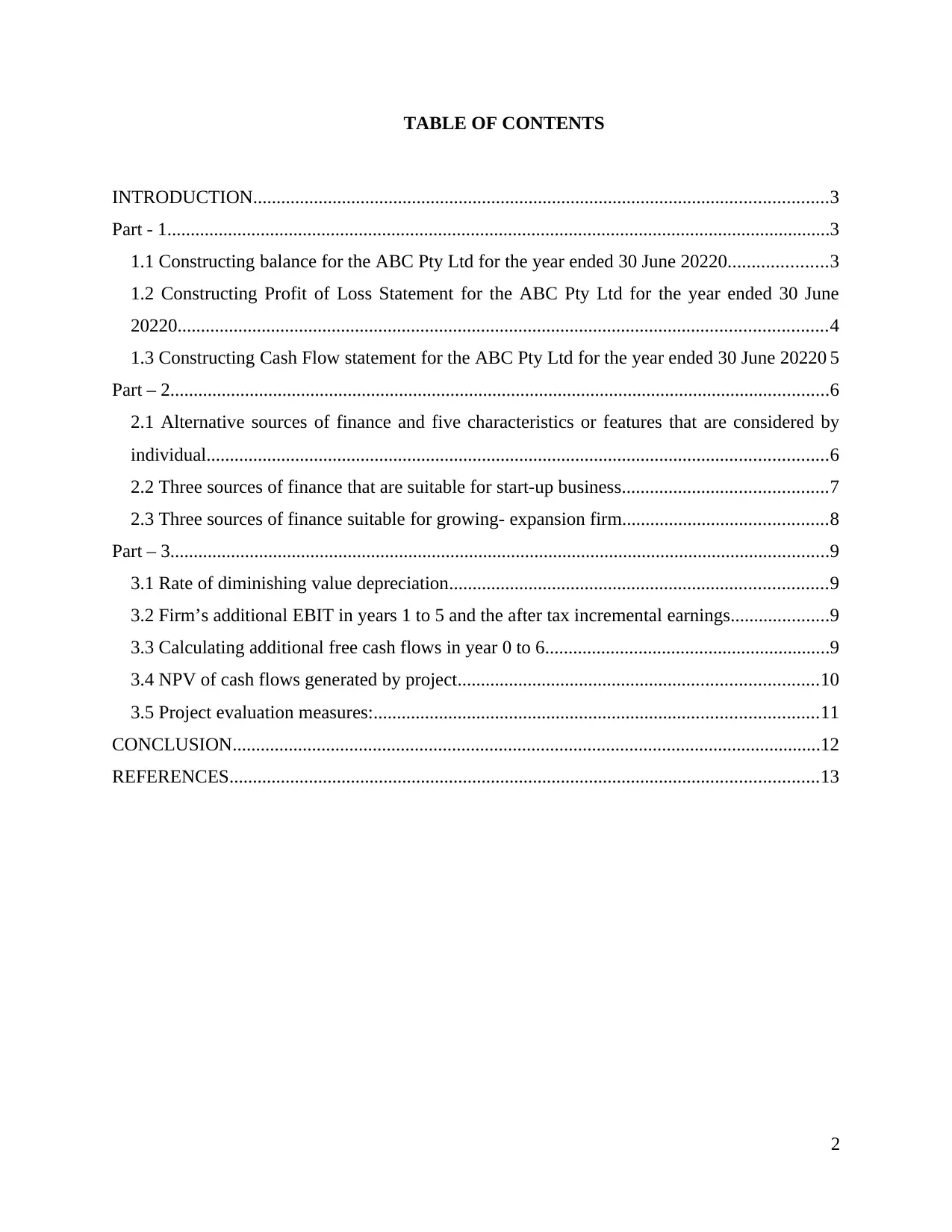
TABLE OF CONTENTS
INTRODUCTION...........................................................................................................................3
Part - 1..............................................................................................................................................3
1.1 Constructing balance for the ABC Pty Ltd for the year ended 30 June 20220.....................3
1.2 Constructing Profit of Loss Statement for the ABC Pty Ltd for the year ended 30 June
20220...........................................................................................................................................4
1.3 Constructing Cash Flow statement for the ABC Pty Ltd for the year ended 30 June 20220 5
Part – 2.............................................................................................................................................6
2.1 Alternative sources of finance and five characteristics or features that are considered by
individual.....................................................................................................................................6
2.2 Three sources of finance that are suitable for start-up business............................................7
2.3 Three sources of finance suitable for growing- expansion firm............................................8
Part – 3.............................................................................................................................................9
3.1 Rate of diminishing value depreciation.................................................................................9
3.2 Firm’s additional EBIT in years 1 to 5 and the after tax incremental earnings.....................9
3.3 Calculating additional free cash flows in year 0 to 6.............................................................9
3.4 NPV of cash flows generated by project.............................................................................10
3.5 Project evaluation measures:...............................................................................................11
CONCLUSION..............................................................................................................................12
REFERENCES..............................................................................................................................13
2
INTRODUCTION...........................................................................................................................3
Part - 1..............................................................................................................................................3
1.1 Constructing balance for the ABC Pty Ltd for the year ended 30 June 20220.....................3
1.2 Constructing Profit of Loss Statement for the ABC Pty Ltd for the year ended 30 June
20220...........................................................................................................................................4
1.3 Constructing Cash Flow statement for the ABC Pty Ltd for the year ended 30 June 20220 5
Part – 2.............................................................................................................................................6
2.1 Alternative sources of finance and five characteristics or features that are considered by
individual.....................................................................................................................................6
2.2 Three sources of finance that are suitable for start-up business............................................7
2.3 Three sources of finance suitable for growing- expansion firm............................................8
Part – 3.............................................................................................................................................9
3.1 Rate of diminishing value depreciation.................................................................................9
3.2 Firm’s additional EBIT in years 1 to 5 and the after tax incremental earnings.....................9
3.3 Calculating additional free cash flows in year 0 to 6.............................................................9
3.4 NPV of cash flows generated by project.............................................................................10
3.5 Project evaluation measures:...............................................................................................11
CONCLUSION..............................................................................................................................12
REFERENCES..............................................................................................................................13
2
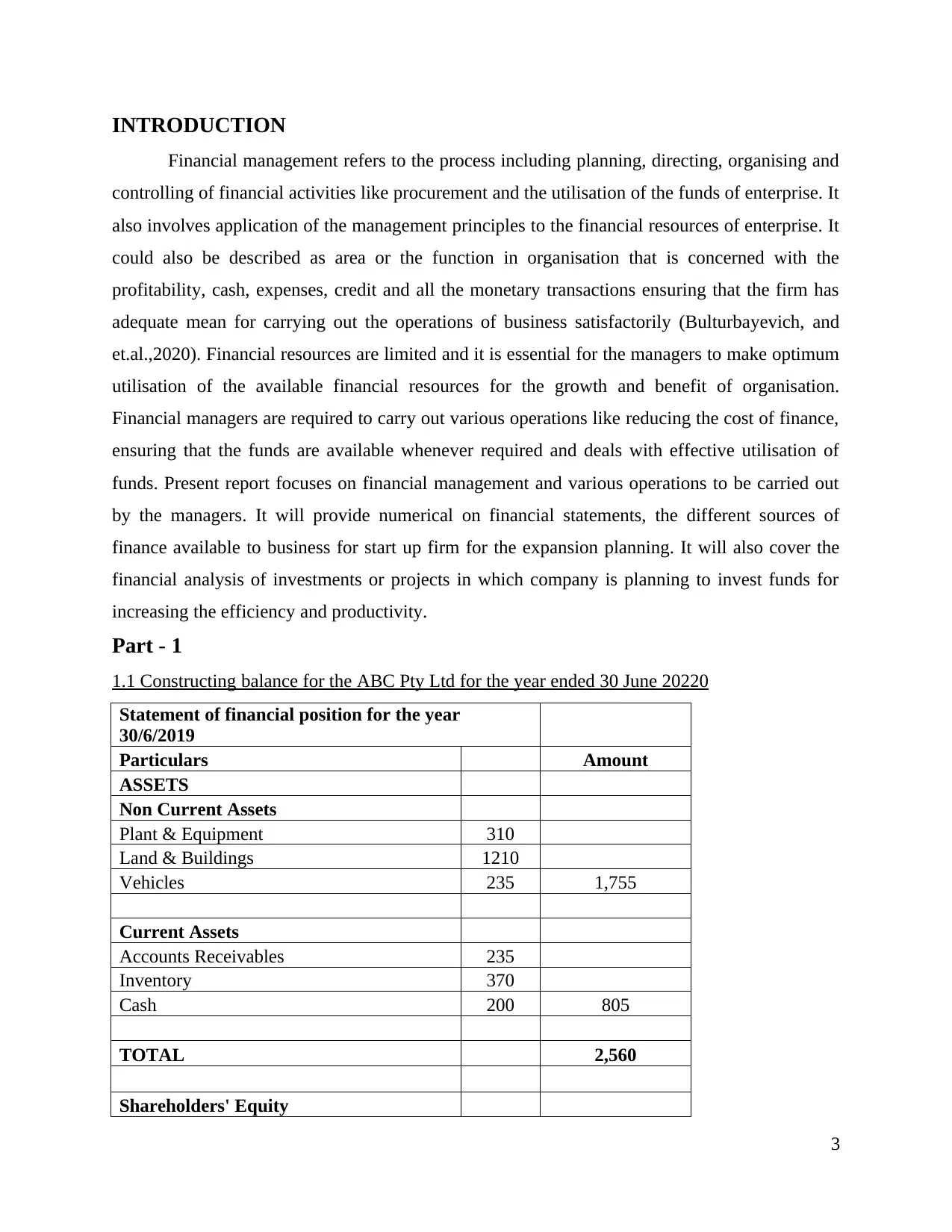
INTRODUCTION
Financial management refers to the process including planning, directing, organising and
controlling of financial activities like procurement and the utilisation of the funds of enterprise. It
also involves application of the management principles to the financial resources of enterprise. It
could also be described as area or the function in organisation that is concerned with the
profitability, cash, expenses, credit and all the monetary transactions ensuring that the firm has
adequate mean for carrying out the operations of business satisfactorily (Bulturbayevich, and
et.al.,2020). Financial resources are limited and it is essential for the managers to make optimum
utilisation of the available financial resources for the growth and benefit of organisation.
Financial managers are required to carry out various operations like reducing the cost of finance,
ensuring that the funds are available whenever required and deals with effective utilisation of
funds. Present report focuses on financial management and various operations to be carried out
by the managers. It will provide numerical on financial statements, the different sources of
finance available to business for start up firm for the expansion planning. It will also cover the
financial analysis of investments or projects in which company is planning to invest funds for
increasing the efficiency and productivity.
Part - 1
1.1 Constructing balance for the ABC Pty Ltd for the year ended 30 June 20220
Statement of financial position for the year
30/6/2019
Particulars Amount
ASSETS
Non Current Assets
Plant & Equipment 310
Land & Buildings 1210
Vehicles 235 1,755
Current Assets
Accounts Receivables 235
Inventory 370
Cash 200 805
TOTAL 2,560
Shareholders' Equity
3
Financial management refers to the process including planning, directing, organising and
controlling of financial activities like procurement and the utilisation of the funds of enterprise. It
also involves application of the management principles to the financial resources of enterprise. It
could also be described as area or the function in organisation that is concerned with the
profitability, cash, expenses, credit and all the monetary transactions ensuring that the firm has
adequate mean for carrying out the operations of business satisfactorily (Bulturbayevich, and
et.al.,2020). Financial resources are limited and it is essential for the managers to make optimum
utilisation of the available financial resources for the growth and benefit of organisation.
Financial managers are required to carry out various operations like reducing the cost of finance,
ensuring that the funds are available whenever required and deals with effective utilisation of
funds. Present report focuses on financial management and various operations to be carried out
by the managers. It will provide numerical on financial statements, the different sources of
finance available to business for start up firm for the expansion planning. It will also cover the
financial analysis of investments or projects in which company is planning to invest funds for
increasing the efficiency and productivity.
Part - 1
1.1 Constructing balance for the ABC Pty Ltd for the year ended 30 June 20220
Statement of financial position for the year
30/6/2019
Particulars Amount
ASSETS
Non Current Assets
Plant & Equipment 310
Land & Buildings 1210
Vehicles 235 1,755
Current Assets
Accounts Receivables 235
Inventory 370
Cash 200 805
TOTAL 2,560
Shareholders' Equity
3
⊘ This is a preview!⊘
Do you want full access?
Subscribe today to unlock all pages.

Trusted by 1+ million students worldwide

Ordinary Shares 690
Preference Shares 260
Retained Earnings 170 1,120
Liabilities
Non Current Liabilities
Corporate Bonds 430
Bank Loan 320 750
Current Liabilities
Accounts Payable 270
Bank overdraft 330
Tax liability 90 690
Total Liabilities 1,440
TOTAL 2,560
1.2 Constructing Profit of Loss Statement for the ABC Pty Ltd for the year ended 30 June 20220
Statement of Profit or Loss for year ended
30/6/2019
Particulars Amount
Sales 992
Other income (dividend received) 50
Total Revenue 1042
Cost of Sales 569
(272+554-257)
Wages 117
Ineterest 27
Utilities 57
Loss from sale of Machinery 10
Rent 82
862
Earnings before tax 180
Tax -10
Earnings after tax 170
4
Preference Shares 260
Retained Earnings 170 1,120
Liabilities
Non Current Liabilities
Corporate Bonds 430
Bank Loan 320 750
Current Liabilities
Accounts Payable 270
Bank overdraft 330
Tax liability 90 690
Total Liabilities 1,440
TOTAL 2,560
1.2 Constructing Profit of Loss Statement for the ABC Pty Ltd for the year ended 30 June 20220
Statement of Profit or Loss for year ended
30/6/2019
Particulars Amount
Sales 992
Other income (dividend received) 50
Total Revenue 1042
Cost of Sales 569
(272+554-257)
Wages 117
Ineterest 27
Utilities 57
Loss from sale of Machinery 10
Rent 82
862
Earnings before tax 180
Tax -10
Earnings after tax 170
4
Paraphrase This Document
Need a fresh take? Get an instant paraphrase of this document with our AI Paraphraser

1.3 Constructing Cash Flow statement for the ABC Pty Ltd for the year ended 30 June 20220
Cash Flow Statement for the year ending 30/6/2020
Particulars Amount Amount
Cash Flow from operating activities
Collection from Customers 460
Cash paid to Suppliers -240
Wages paid -130
Taxes paid -8
Cash Flow from operating activities 82
Cash Flow from Investing activities
Sale of PPE 80
Dividend Received 9
Purchase of new PPE -350
Cash Flow from investing activities -261
Cash Flow from Financing activities
Proceeds from long term borrowings 155
Proceeds from issue of new shares 85
Interest paid -12
Dividend Paid -26
Buying back of shares -31
Repayment of long term borrowings -24
Payment of Finance leade -48
Cash Flow from financing activities 99
Cash at beginning of the year 270
Net Cash flow for the year -80
Cash at ending of the year 190
5
Cash Flow Statement for the year ending 30/6/2020
Particulars Amount Amount
Cash Flow from operating activities
Collection from Customers 460
Cash paid to Suppliers -240
Wages paid -130
Taxes paid -8
Cash Flow from operating activities 82
Cash Flow from Investing activities
Sale of PPE 80
Dividend Received 9
Purchase of new PPE -350
Cash Flow from investing activities -261
Cash Flow from Financing activities
Proceeds from long term borrowings 155
Proceeds from issue of new shares 85
Interest paid -12
Dividend Paid -26
Buying back of shares -31
Repayment of long term borrowings -24
Payment of Finance leade -48
Cash Flow from financing activities 99
Cash at beginning of the year 270
Net Cash flow for the year -80
Cash at ending of the year 190
5
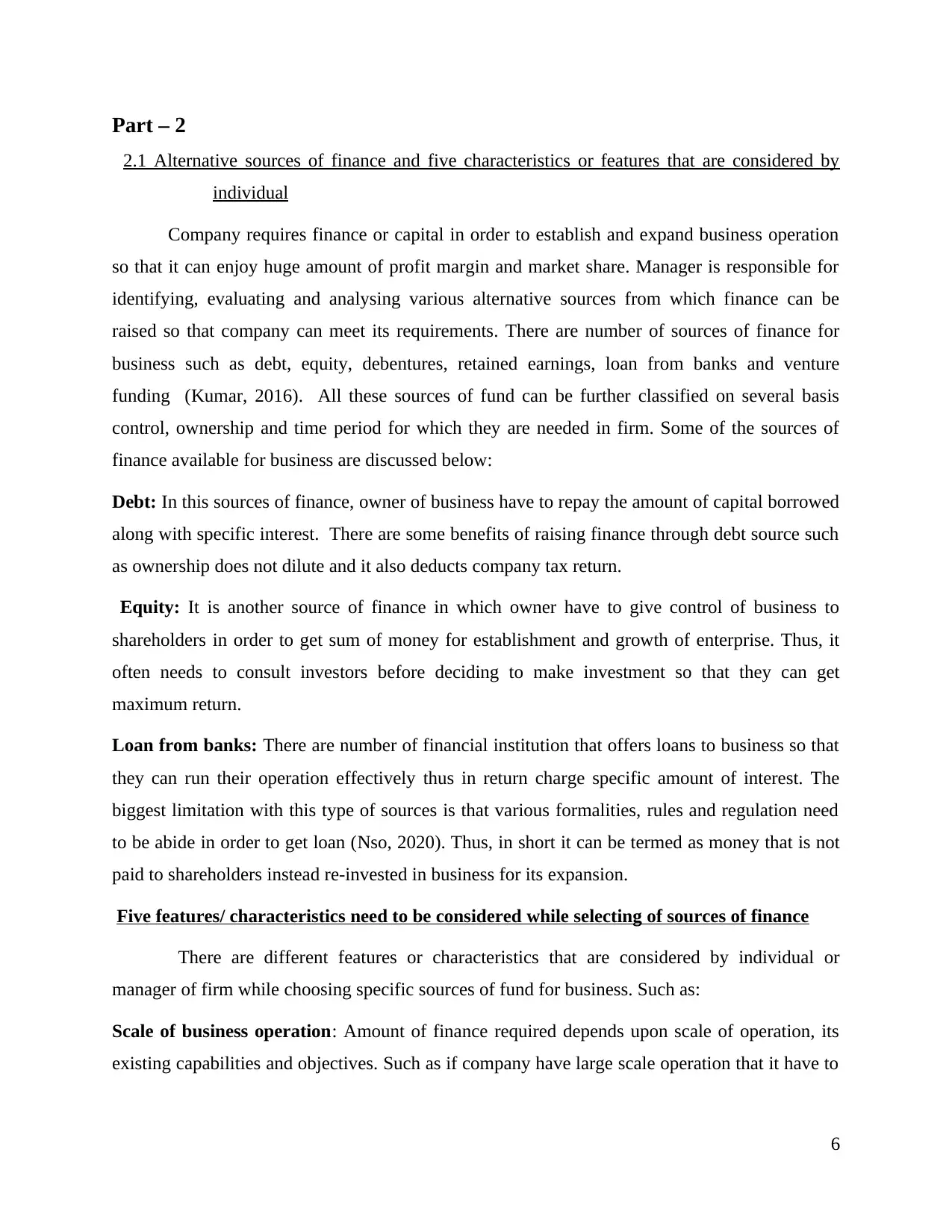
Part – 2
2.1 Alternative sources of finance and five characteristics or features that are considered by
individual
Company requires finance or capital in order to establish and expand business operation
so that it can enjoy huge amount of profit margin and market share. Manager is responsible for
identifying, evaluating and analysing various alternative sources from which finance can be
raised so that company can meet its requirements. There are number of sources of finance for
business such as debt, equity, debentures, retained earnings, loan from banks and venture
funding (Kumar, 2016). All these sources of fund can be further classified on several basis
control, ownership and time period for which they are needed in firm. Some of the sources of
finance available for business are discussed below:
Debt: In this sources of finance, owner of business have to repay the amount of capital borrowed
along with specific interest. There are some benefits of raising finance through debt source such
as ownership does not dilute and it also deducts company tax return.
Equity: It is another source of finance in which owner have to give control of business to
shareholders in order to get sum of money for establishment and growth of enterprise. Thus, it
often needs to consult investors before deciding to make investment so that they can get
maximum return.
Loan from banks: There are number of financial institution that offers loans to business so that
they can run their operation effectively thus in return charge specific amount of interest. The
biggest limitation with this type of sources is that various formalities, rules and regulation need
to be abide in order to get loan (Nso, 2020). Thus, in short it can be termed as money that is not
paid to shareholders instead re-invested in business for its expansion.
Five features/ characteristics need to be considered while selecting of sources of finance
There are different features or characteristics that are considered by individual or
manager of firm while choosing specific sources of fund for business. Such as:
Scale of business operation: Amount of finance required depends upon scale of operation, its
existing capabilities and objectives. Such as if company have large scale operation that it have to
6
2.1 Alternative sources of finance and five characteristics or features that are considered by
individual
Company requires finance or capital in order to establish and expand business operation
so that it can enjoy huge amount of profit margin and market share. Manager is responsible for
identifying, evaluating and analysing various alternative sources from which finance can be
raised so that company can meet its requirements. There are number of sources of finance for
business such as debt, equity, debentures, retained earnings, loan from banks and venture
funding (Kumar, 2016). All these sources of fund can be further classified on several basis
control, ownership and time period for which they are needed in firm. Some of the sources of
finance available for business are discussed below:
Debt: In this sources of finance, owner of business have to repay the amount of capital borrowed
along with specific interest. There are some benefits of raising finance through debt source such
as ownership does not dilute and it also deducts company tax return.
Equity: It is another source of finance in which owner have to give control of business to
shareholders in order to get sum of money for establishment and growth of enterprise. Thus, it
often needs to consult investors before deciding to make investment so that they can get
maximum return.
Loan from banks: There are number of financial institution that offers loans to business so that
they can run their operation effectively thus in return charge specific amount of interest. The
biggest limitation with this type of sources is that various formalities, rules and regulation need
to be abide in order to get loan (Nso, 2020). Thus, in short it can be termed as money that is not
paid to shareholders instead re-invested in business for its expansion.
Five features/ characteristics need to be considered while selecting of sources of finance
There are different features or characteristics that are considered by individual or
manager of firm while choosing specific sources of fund for business. Such as:
Scale of business operation: Amount of finance required depends upon scale of operation, its
existing capabilities and objectives. Such as if company have large scale operation that it have to
6
⊘ This is a preview!⊘
Do you want full access?
Subscribe today to unlock all pages.

Trusted by 1+ million students worldwide
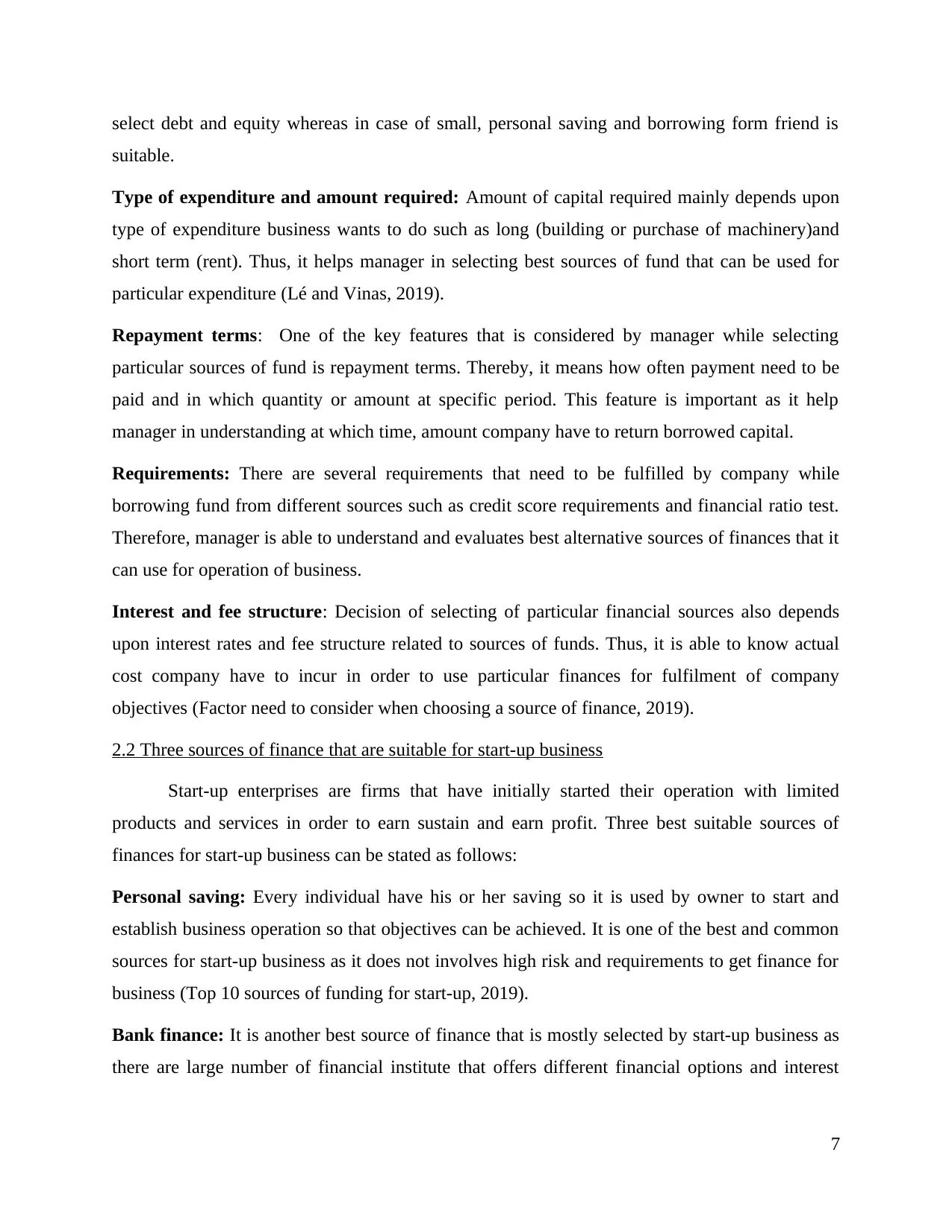
select debt and equity whereas in case of small, personal saving and borrowing form friend is
suitable.
Type of expenditure and amount required: Amount of capital required mainly depends upon
type of expenditure business wants to do such as long (building or purchase of machinery)and
short term (rent). Thus, it helps manager in selecting best sources of fund that can be used for
particular expenditure (Lé and Vinas, 2019).
Repayment terms: One of the key features that is considered by manager while selecting
particular sources of fund is repayment terms. Thereby, it means how often payment need to be
paid and in which quantity or amount at specific period. This feature is important as it help
manager in understanding at which time, amount company have to return borrowed capital.
Requirements: There are several requirements that need to be fulfilled by company while
borrowing fund from different sources such as credit score requirements and financial ratio test.
Therefore, manager is able to understand and evaluates best alternative sources of finances that it
can use for operation of business.
Interest and fee structure: Decision of selecting of particular financial sources also depends
upon interest rates and fee structure related to sources of funds. Thus, it is able to know actual
cost company have to incur in order to use particular finances for fulfilment of company
objectives (Factor need to consider when choosing a source of finance, 2019).
2.2 Three sources of finance that are suitable for start-up business
Start-up enterprises are firms that have initially started their operation with limited
products and services in order to earn sustain and earn profit. Three best suitable sources of
finances for start-up business can be stated as follows:
Personal saving: Every individual have his or her saving so it is used by owner to start and
establish business operation so that objectives can be achieved. It is one of the best and common
sources for start-up business as it does not involves high risk and requirements to get finance for
business (Top 10 sources of funding for start-up, 2019).
Bank finance: It is another best source of finance that is mostly selected by start-up business as
there are large number of financial institute that offers different financial options and interest
7
suitable.
Type of expenditure and amount required: Amount of capital required mainly depends upon
type of expenditure business wants to do such as long (building or purchase of machinery)and
short term (rent). Thus, it helps manager in selecting best sources of fund that can be used for
particular expenditure (Lé and Vinas, 2019).
Repayment terms: One of the key features that is considered by manager while selecting
particular sources of fund is repayment terms. Thereby, it means how often payment need to be
paid and in which quantity or amount at specific period. This feature is important as it help
manager in understanding at which time, amount company have to return borrowed capital.
Requirements: There are several requirements that need to be fulfilled by company while
borrowing fund from different sources such as credit score requirements and financial ratio test.
Therefore, manager is able to understand and evaluates best alternative sources of finances that it
can use for operation of business.
Interest and fee structure: Decision of selecting of particular financial sources also depends
upon interest rates and fee structure related to sources of funds. Thus, it is able to know actual
cost company have to incur in order to use particular finances for fulfilment of company
objectives (Factor need to consider when choosing a source of finance, 2019).
2.2 Three sources of finance that are suitable for start-up business
Start-up enterprises are firms that have initially started their operation with limited
products and services in order to earn sustain and earn profit. Three best suitable sources of
finances for start-up business can be stated as follows:
Personal saving: Every individual have his or her saving so it is used by owner to start and
establish business operation so that objectives can be achieved. It is one of the best and common
sources for start-up business as it does not involves high risk and requirements to get finance for
business (Top 10 sources of funding for start-up, 2019).
Bank finance: It is another best source of finance that is mostly selected by start-up business as
there are large number of financial institute that offers different financial options and interest
7
Paraphrase This Document
Need a fresh take? Get an instant paraphrase of this document with our AI Paraphraser
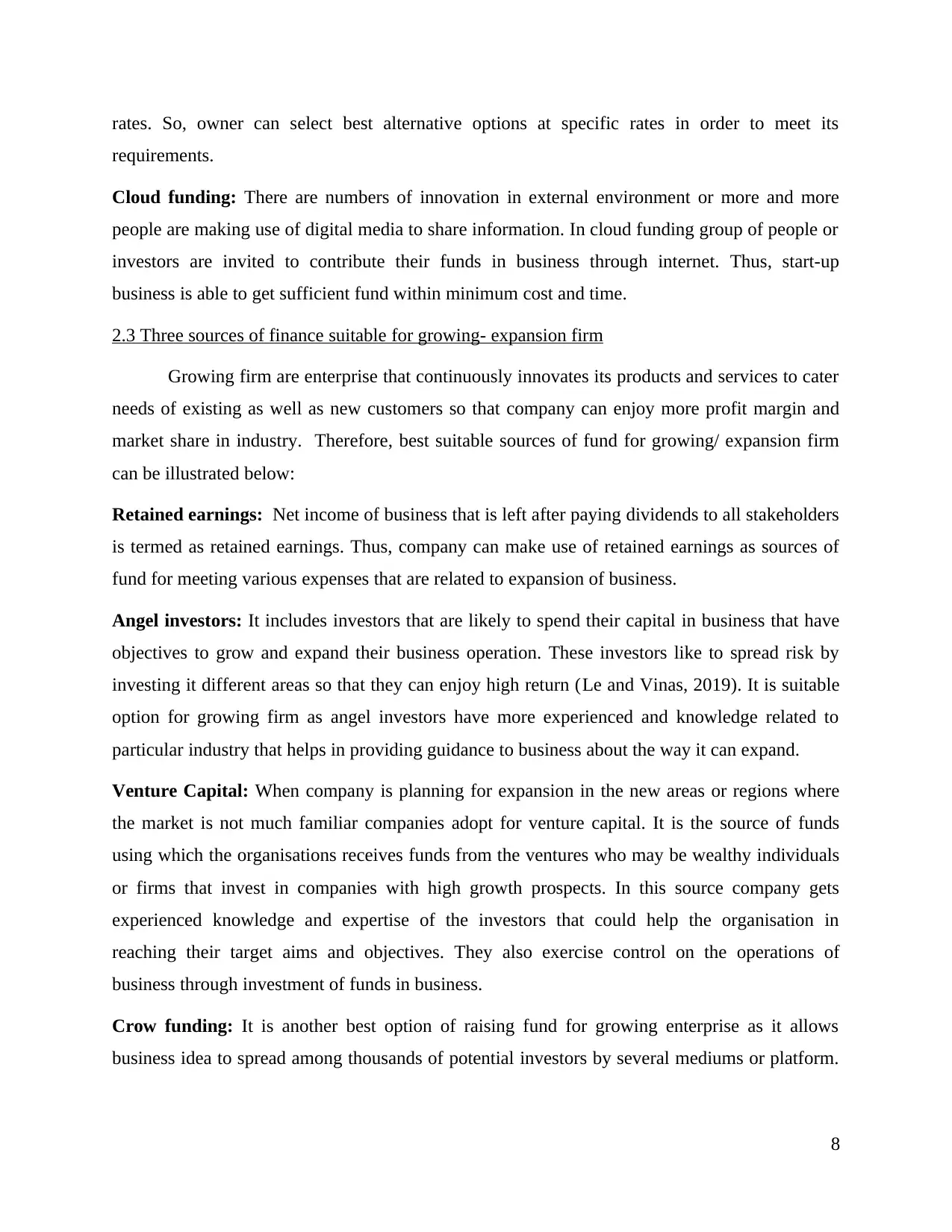
rates. So, owner can select best alternative options at specific rates in order to meet its
requirements.
Cloud funding: There are numbers of innovation in external environment or more and more
people are making use of digital media to share information. In cloud funding group of people or
investors are invited to contribute their funds in business through internet. Thus, start-up
business is able to get sufficient fund within minimum cost and time.
2.3 Three sources of finance suitable for growing- expansion firm
Growing firm are enterprise that continuously innovates its products and services to cater
needs of existing as well as new customers so that company can enjoy more profit margin and
market share in industry. Therefore, best suitable sources of fund for growing/ expansion firm
can be illustrated below:
Retained earnings: Net income of business that is left after paying dividends to all stakeholders
is termed as retained earnings. Thus, company can make use of retained earnings as sources of
fund for meeting various expenses that are related to expansion of business.
Angel investors: It includes investors that are likely to spend their capital in business that have
objectives to grow and expand their business operation. These investors like to spread risk by
investing it different areas so that they can enjoy high return (Le and Vinas, 2019). It is suitable
option for growing firm as angel investors have more experienced and knowledge related to
particular industry that helps in providing guidance to business about the way it can expand.
Venture Capital: When company is planning for expansion in the new areas or regions where
the market is not much familiar companies adopt for venture capital. It is the source of funds
using which the organisations receives funds from the ventures who may be wealthy individuals
or firms that invest in companies with high growth prospects. In this source company gets
experienced knowledge and expertise of the investors that could help the organisation in
reaching their target aims and objectives. They also exercise control on the operations of
business through investment of funds in business.
Crow funding: It is another best option of raising fund for growing enterprise as it allows
business idea to spread among thousands of potential investors by several mediums or platform.
8
requirements.
Cloud funding: There are numbers of innovation in external environment or more and more
people are making use of digital media to share information. In cloud funding group of people or
investors are invited to contribute their funds in business through internet. Thus, start-up
business is able to get sufficient fund within minimum cost and time.
2.3 Three sources of finance suitable for growing- expansion firm
Growing firm are enterprise that continuously innovates its products and services to cater
needs of existing as well as new customers so that company can enjoy more profit margin and
market share in industry. Therefore, best suitable sources of fund for growing/ expansion firm
can be illustrated below:
Retained earnings: Net income of business that is left after paying dividends to all stakeholders
is termed as retained earnings. Thus, company can make use of retained earnings as sources of
fund for meeting various expenses that are related to expansion of business.
Angel investors: It includes investors that are likely to spend their capital in business that have
objectives to grow and expand their business operation. These investors like to spread risk by
investing it different areas so that they can enjoy high return (Le and Vinas, 2019). It is suitable
option for growing firm as angel investors have more experienced and knowledge related to
particular industry that helps in providing guidance to business about the way it can expand.
Venture Capital: When company is planning for expansion in the new areas or regions where
the market is not much familiar companies adopt for venture capital. It is the source of funds
using which the organisations receives funds from the ventures who may be wealthy individuals
or firms that invest in companies with high growth prospects. In this source company gets
experienced knowledge and expertise of the investors that could help the organisation in
reaching their target aims and objectives. They also exercise control on the operations of
business through investment of funds in business.
Crow funding: It is another best option of raising fund for growing enterprise as it allows
business idea to spread among thousands of potential investors by several mediums or platform.
8
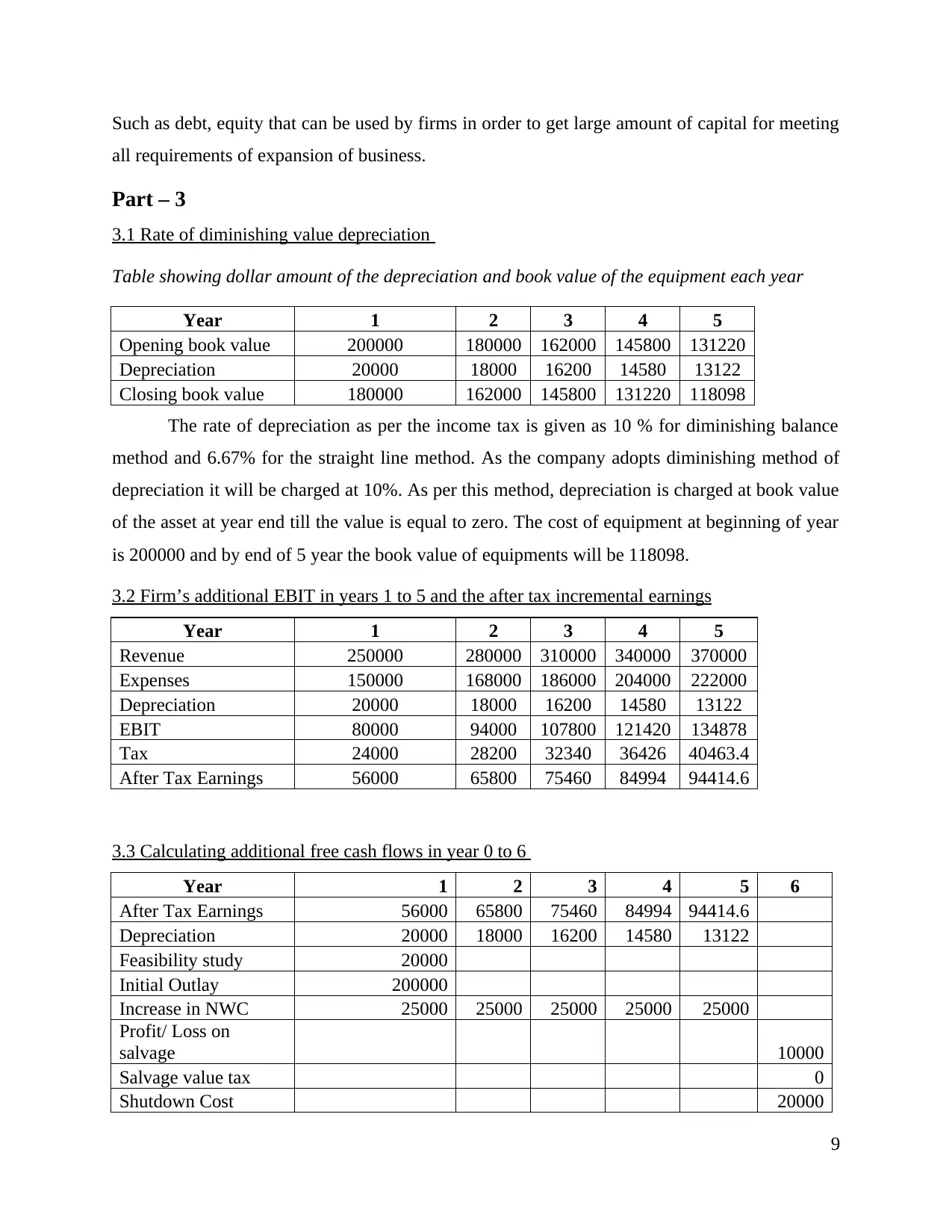
Such as debt, equity that can be used by firms in order to get large amount of capital for meeting
all requirements of expansion of business.
Part – 3
3.1 Rate of diminishing value depreciation
Table showing dollar amount of the depreciation and book value of the equipment each year
Year 1 2 3 4 5
Opening book value 200000 180000 162000 145800 131220
Depreciation 20000 18000 16200 14580 13122
Closing book value 180000 162000 145800 131220 118098
The rate of depreciation as per the income tax is given as 10 % for diminishing balance
method and 6.67% for the straight line method. As the company adopts diminishing method of
depreciation it will be charged at 10%. As per this method, depreciation is charged at book value
of the asset at year end till the value is equal to zero. The cost of equipment at beginning of year
is 200000 and by end of 5 year the book value of equipments will be 118098.
3.2 Firm’s additional EBIT in years 1 to 5 and the after tax incremental earnings
Year 1 2 3 4 5
Revenue 250000 280000 310000 340000 370000
Expenses 150000 168000 186000 204000 222000
Depreciation 20000 18000 16200 14580 13122
EBIT 80000 94000 107800 121420 134878
Tax 24000 28200 32340 36426 40463.4
After Tax Earnings 56000 65800 75460 84994 94414.6
3.3 Calculating additional free cash flows in year 0 to 6
Year 1 2 3 4 5 6
After Tax Earnings 56000 65800 75460 84994 94414.6
Depreciation 20000 18000 16200 14580 13122
Feasibility study 20000
Initial Outlay 200000
Increase in NWC 25000 25000 25000 25000 25000
Profit/ Loss on
salvage 10000
Salvage value tax 0
Shutdown Cost 20000
9
all requirements of expansion of business.
Part – 3
3.1 Rate of diminishing value depreciation
Table showing dollar amount of the depreciation and book value of the equipment each year
Year 1 2 3 4 5
Opening book value 200000 180000 162000 145800 131220
Depreciation 20000 18000 16200 14580 13122
Closing book value 180000 162000 145800 131220 118098
The rate of depreciation as per the income tax is given as 10 % for diminishing balance
method and 6.67% for the straight line method. As the company adopts diminishing method of
depreciation it will be charged at 10%. As per this method, depreciation is charged at book value
of the asset at year end till the value is equal to zero. The cost of equipment at beginning of year
is 200000 and by end of 5 year the book value of equipments will be 118098.
3.2 Firm’s additional EBIT in years 1 to 5 and the after tax incremental earnings
Year 1 2 3 4 5
Revenue 250000 280000 310000 340000 370000
Expenses 150000 168000 186000 204000 222000
Depreciation 20000 18000 16200 14580 13122
EBIT 80000 94000 107800 121420 134878
Tax 24000 28200 32340 36426 40463.4
After Tax Earnings 56000 65800 75460 84994 94414.6
3.3 Calculating additional free cash flows in year 0 to 6
Year 1 2 3 4 5 6
After Tax Earnings 56000 65800 75460 84994 94414.6
Depreciation 20000 18000 16200 14580 13122
Feasibility study 20000
Initial Outlay 200000
Increase in NWC 25000 25000 25000 25000 25000
Profit/ Loss on
salvage 10000
Salvage value tax 0
Shutdown Cost 20000
9
⊘ This is a preview!⊘
Do you want full access?
Subscribe today to unlock all pages.

Trusted by 1+ million students worldwide

Shutdown Cost Tax 0
Free Cash Flow 51000 58800 66660 74574 82536.6
3.4 NPV of cash flows generated by project
Net present value is the method used by the company for evaluating the profitability of
investment or project. It is an effective technique that that estimates the present value of future
cash flows for identifying whether the cash flows are enough for covering the cost of project.
This is an essential technique used for assessing the viability of the project. The advantage of this
technique is that it considers the time value of money which is not considered in other techniques
of investment appraisal. The drawback is that it does not consider the other cash flows from the
project.
Computation of NPV
Year
Cash
inflows
PV
factor
@
8.9%
Discounted
cash
inflows
1 51000 0.918 46832
2 58800 0.843 49582
3 66660 0.774 51616
4 74574 0.711 53024
5 92536 0.653 60419
Total discounted cash
inflow 261472
Initial investment 200000
NPV (Total discounted
cash inflows - initial
investment) 61472
Interpretation
It could be evaluated from the above technique that net present value of project is 61472.
It is essential for the business to evaluate appropriately the business project as it involves large
amount of cash of business. The NPV of the project is positive which shows that project will be
10
Free Cash Flow 51000 58800 66660 74574 82536.6
3.4 NPV of cash flows generated by project
Net present value is the method used by the company for evaluating the profitability of
investment or project. It is an effective technique that that estimates the present value of future
cash flows for identifying whether the cash flows are enough for covering the cost of project.
This is an essential technique used for assessing the viability of the project. The advantage of this
technique is that it considers the time value of money which is not considered in other techniques
of investment appraisal. The drawback is that it does not consider the other cash flows from the
project.
Computation of NPV
Year
Cash
inflows
PV
factor
@
8.9%
Discounted
cash
inflows
1 51000 0.918 46832
2 58800 0.843 49582
3 66660 0.774 51616
4 74574 0.711 53024
5 92536 0.653 60419
Total discounted cash
inflow 261472
Initial investment 200000
NPV (Total discounted
cash inflows - initial
investment) 61472
Interpretation
It could be evaluated from the above technique that net present value of project is 61472.
It is essential for the business to evaluate appropriately the business project as it involves large
amount of cash of business. The NPV of the project is positive which shows that project will be
10
Paraphrase This Document
Need a fresh take? Get an instant paraphrase of this document with our AI Paraphraser
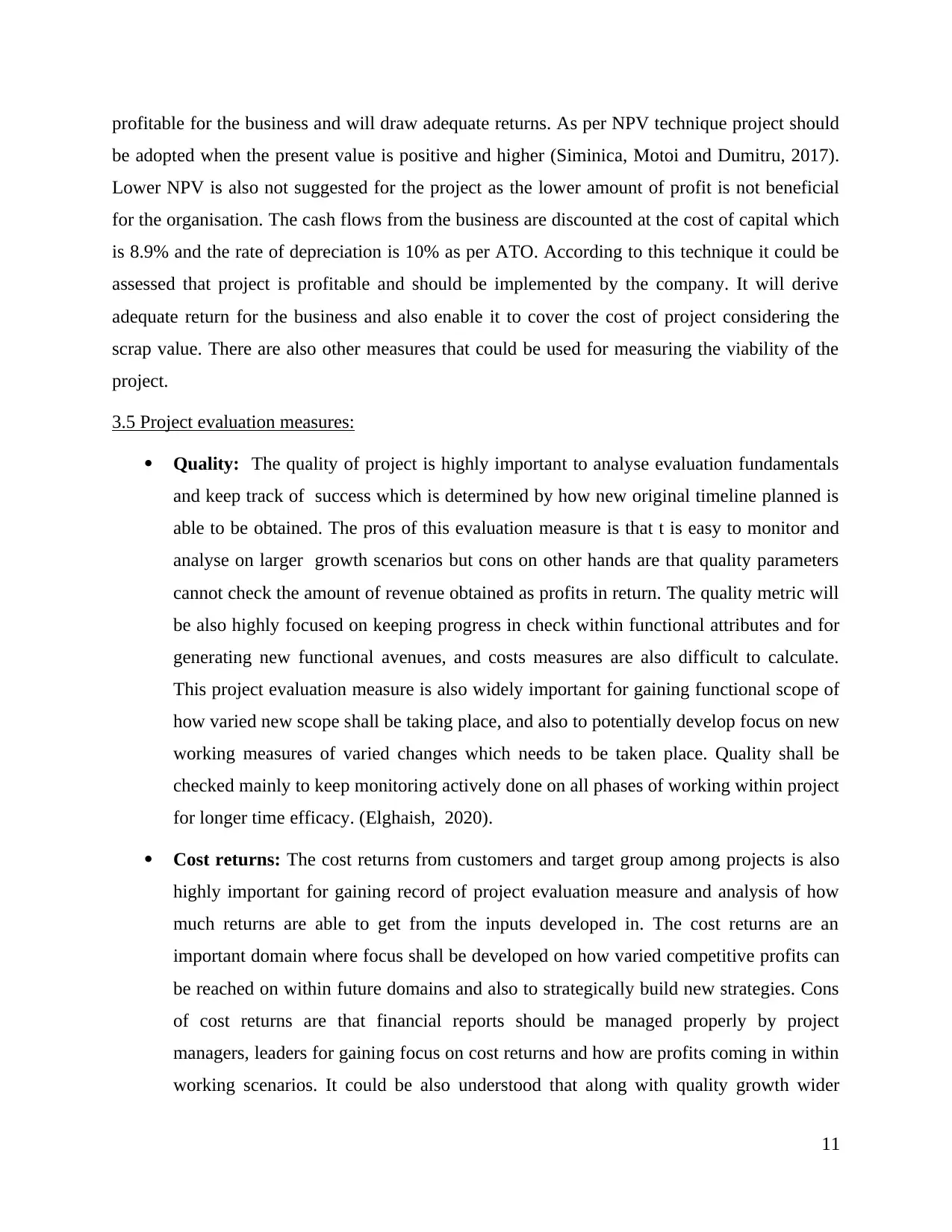
profitable for the business and will draw adequate returns. As per NPV technique project should
be adopted when the present value is positive and higher (Siminica, Motoi and Dumitru, 2017).
Lower NPV is also not suggested for the project as the lower amount of profit is not beneficial
for the organisation. The cash flows from the business are discounted at the cost of capital which
is 8.9% and the rate of depreciation is 10% as per ATO. According to this technique it could be
assessed that project is profitable and should be implemented by the company. It will derive
adequate return for the business and also enable it to cover the cost of project considering the
scrap value. There are also other measures that could be used for measuring the viability of the
project.
3.5 Project evaluation measures:
Quality: The quality of project is highly important to analyse evaluation fundamentals
and keep track of success which is determined by how new original timeline planned is
able to be obtained. The pros of this evaluation measure is that t is easy to monitor and
analyse on larger growth scenarios but cons on other hands are that quality parameters
cannot check the amount of revenue obtained as profits in return. The quality metric will
be also highly focused on keeping progress in check within functional attributes and for
generating new functional avenues, and costs measures are also difficult to calculate.
This project evaluation measure is also widely important for gaining functional scope of
how varied new scope shall be taking place, and also to potentially develop focus on new
working measures of varied changes which needs to be taken place. Quality shall be
checked mainly to keep monitoring actively done on all phases of working within project
for longer time efficacy. (Elghaish, 2020).
Cost returns: The cost returns from customers and target group among projects is also
highly important for gaining record of project evaluation measure and analysis of how
much returns are able to get from the inputs developed in. The cost returns are an
important domain where focus shall be developed on how varied competitive profits can
be reached on within future domains and also to strategically build new strategies. Cons
of cost returns are that financial reports should be managed properly by project
managers, leaders for gaining focus on cost returns and how are profits coming in within
working scenarios. It could be also understood that along with quality growth wider
11
be adopted when the present value is positive and higher (Siminica, Motoi and Dumitru, 2017).
Lower NPV is also not suggested for the project as the lower amount of profit is not beneficial
for the organisation. The cash flows from the business are discounted at the cost of capital which
is 8.9% and the rate of depreciation is 10% as per ATO. According to this technique it could be
assessed that project is profitable and should be implemented by the company. It will derive
adequate return for the business and also enable it to cover the cost of project considering the
scrap value. There are also other measures that could be used for measuring the viability of the
project.
3.5 Project evaluation measures:
Quality: The quality of project is highly important to analyse evaluation fundamentals
and keep track of success which is determined by how new original timeline planned is
able to be obtained. The pros of this evaluation measure is that t is easy to monitor and
analyse on larger growth scenarios but cons on other hands are that quality parameters
cannot check the amount of revenue obtained as profits in return. The quality metric will
be also highly focused on keeping progress in check within functional attributes and for
generating new functional avenues, and costs measures are also difficult to calculate.
This project evaluation measure is also widely important for gaining functional scope of
how varied new scope shall be taking place, and also to potentially develop focus on new
working measures of varied changes which needs to be taken place. Quality shall be
checked mainly to keep monitoring actively done on all phases of working within project
for longer time efficacy. (Elghaish, 2020).
Cost returns: The cost returns from customers and target group among projects is also
highly important for gaining record of project evaluation measure and analysis of how
much returns are able to get from the inputs developed in. The cost returns are an
important domain where focus shall be developed on how varied competitive profits can
be reached on within future domains and also to strategically build new strategies. Cons
of cost returns are that financial reports should be managed properly by project
managers, leaders for gaining focus on cost returns and how are profits coming in within
working scenarios. It could be also understood that along with quality growth wider
11
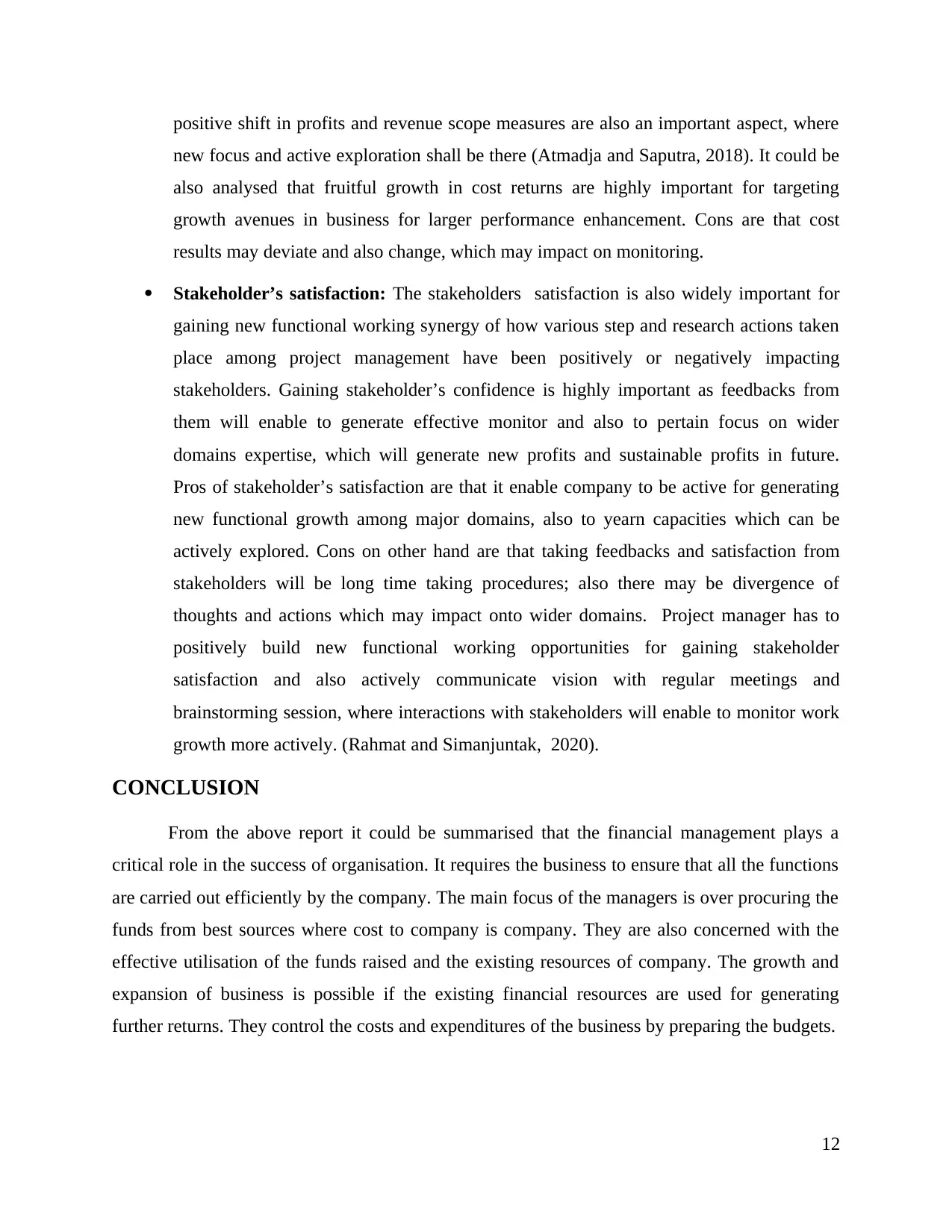
positive shift in profits and revenue scope measures are also an important aspect, where
new focus and active exploration shall be there (Atmadja and Saputra, 2018). It could be
also analysed that fruitful growth in cost returns are highly important for targeting
growth avenues in business for larger performance enhancement. Cons are that cost
results may deviate and also change, which may impact on monitoring.
Stakeholder’s satisfaction: The stakeholders satisfaction is also widely important for
gaining new functional working synergy of how various step and research actions taken
place among project management have been positively or negatively impacting
stakeholders. Gaining stakeholder’s confidence is highly important as feedbacks from
them will enable to generate effective monitor and also to pertain focus on wider
domains expertise, which will generate new profits and sustainable profits in future.
Pros of stakeholder’s satisfaction are that it enable company to be active for generating
new functional growth among major domains, also to yearn capacities which can be
actively explored. Cons on other hand are that taking feedbacks and satisfaction from
stakeholders will be long time taking procedures; also there may be divergence of
thoughts and actions which may impact onto wider domains. Project manager has to
positively build new functional working opportunities for gaining stakeholder
satisfaction and also actively communicate vision with regular meetings and
brainstorming session, where interactions with stakeholders will enable to monitor work
growth more actively. (Rahmat and Simanjuntak, 2020).
CONCLUSION
From the above report it could be summarised that the financial management plays a
critical role in the success of organisation. It requires the business to ensure that all the functions
are carried out efficiently by the company. The main focus of the managers is over procuring the
funds from best sources where cost to company is company. They are also concerned with the
effective utilisation of the funds raised and the existing resources of company. The growth and
expansion of business is possible if the existing financial resources are used for generating
further returns. They control the costs and expenditures of the business by preparing the budgets.
12
new focus and active exploration shall be there (Atmadja and Saputra, 2018). It could be
also analysed that fruitful growth in cost returns are highly important for targeting
growth avenues in business for larger performance enhancement. Cons are that cost
results may deviate and also change, which may impact on monitoring.
Stakeholder’s satisfaction: The stakeholders satisfaction is also widely important for
gaining new functional working synergy of how various step and research actions taken
place among project management have been positively or negatively impacting
stakeholders. Gaining stakeholder’s confidence is highly important as feedbacks from
them will enable to generate effective monitor and also to pertain focus on wider
domains expertise, which will generate new profits and sustainable profits in future.
Pros of stakeholder’s satisfaction are that it enable company to be active for generating
new functional growth among major domains, also to yearn capacities which can be
actively explored. Cons on other hand are that taking feedbacks and satisfaction from
stakeholders will be long time taking procedures; also there may be divergence of
thoughts and actions which may impact onto wider domains. Project manager has to
positively build new functional working opportunities for gaining stakeholder
satisfaction and also actively communicate vision with regular meetings and
brainstorming session, where interactions with stakeholders will enable to monitor work
growth more actively. (Rahmat and Simanjuntak, 2020).
CONCLUSION
From the above report it could be summarised that the financial management plays a
critical role in the success of organisation. It requires the business to ensure that all the functions
are carried out efficiently by the company. The main focus of the managers is over procuring the
funds from best sources where cost to company is company. They are also concerned with the
effective utilisation of the funds raised and the existing resources of company. The growth and
expansion of business is possible if the existing financial resources are used for generating
further returns. They control the costs and expenditures of the business by preparing the budgets.
12
⊘ This is a preview!⊘
Do you want full access?
Subscribe today to unlock all pages.

Trusted by 1+ million students worldwide
1 out of 14
Related Documents
Your All-in-One AI-Powered Toolkit for Academic Success.
+13062052269
info@desklib.com
Available 24*7 on WhatsApp / Email
![[object Object]](/_next/static/media/star-bottom.7253800d.svg)
Unlock your academic potential
Copyright © 2020–2025 A2Z Services. All Rights Reserved. Developed and managed by ZUCOL.





